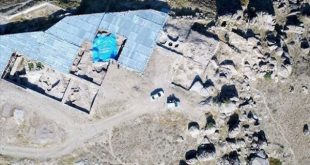 Archaeologists have described the discovery, which had to hide a few years.
Archaeologists have described the discovery, which had to hide a few years.
French archaeologists have told about the astonishing discovery that they had to hide for several years. Engraving of Plougastel. The head of bison Rock Empress in the city of Plougastel.
His silence explain: the site was required to protect from black diggers loitering and public. Only now, archaeologists have published the first results of the research and revealed some details, including findings. The beginning of this story put the hurricane that swept over the French region Bretagne in 1987. The wind uprooted a pine on the top of the Cliff of the Empress – 50-foot cliff on the edge of the Breton city of Plougastel-Daoulas on the Atlantic coast of France.
During the inspection of the damage in the pit left from the dead trees, specialists have discovered an interesting archaeological material. Excavations began that continued for many years – the rock stands on the banks overgrown with trees, so the use of modern technology was impossible, everything had to be done the old fashioned way, manually. 26 years later, in the summer of 2013, researchers reached the foot of the Cliff of the Empress, where he found a small cave – like grotto, shelters under the rock. From there, the archaeologists under the leadership of Nicolas Nadine (Nicolas Naudinot) removed many artifacts of the Paleolithic era – flint arrowheads, stone knives, scrapers…
From 2013 these items already scored 4659. All of them are of interest to science, but the absolute sensation were only 45 of them. We are talking about the artifacts that archaeologists call “prehistoric prints”: 45 slate signs with images of animals such as horses and bison.
The age of “engravings”, scratched in the soft stone, drawn or multiple stained coal, to more than 14,000 years. Unlike large-scale “paintings” prehistoric artists on the walls of such caves as Lascaux (France), Altamira (Spain) or Shulgan-Tash (Russia), slate engravings from Plougastel very small: 29 of them less than five inches in length, 14 – less than 10 cm in length, and only two rather large, almost 30 cm, with well-preserved images on both sides of the stone is the mirror “portraits” of horses and bison.
“We are absolutely struck by the beauty of these drawings and amazing skills of the artist. The details are drawn very skillfully on the images of horses, for example, easily distinguishable hooves, mane, standing next to the foal… the Drawings are very lively and talking,” — said Nicolas Nadine the French newspaper Le Figaro.
Archaeologists remember how after the discovery of the first prints in 2013 they had to postpone shovels to prevent damaging the fragile slate, and go to the most sensitive tools – shovels, garden shovels, brushes… And the researchers also sought from the regional authorities the full protection of the Cliff of the Empress from outsiders. All of these measures have slowed the process of excavation, but the discovery was worth it. Engravings of Plougastel – one of the oldest works of art found in Brittany, but they cannot be called a discovery of local importance.
These images, especially given their age, is extremely rare in Europe. One of them is the head of a bison surrounded by rays – unique: such symbols had never met a scientist. However, speaking of age, archaeologists have in mind not only the antiquity of the slate prints: the same drawings of the already mentioned famous caves for a few thousand years older than engravings of Plougastel. Here it is in the period to which they relate scientists. “For the French and European archaeology these engravings are of great value, as they refer to the transitional period, previously unknown to researchers. Is the transition from the figurative art of the magdalenian culture to a much more schematic and geometric art asilsoy culture,” explains Nadine.
Perhaps, to the explanation of the scientist is to add more obscure words to more clearly explain the historical value of the finds. One of those words – Allered, or Allerease warming climatic period classification Blitt-Sernander. About 14500 years ago, the climate of Europe was warm and humid, and after Allerede on the continent again cold. Even today we feel the consequences of global warming, but in the prehistoric era together with the change of climate was changing everything, including the social organization of the people and such thin material as art. Until now it was thought that Allerease warming put an end to madlensky culture with its delicate and very realistic graphical style. The name of the era, madlensky, goes back to the cave of La Madelaine in the South of France, where in the XIX century was discovered a beautiful prehistoric carvings and incised in stone images of people and animals.
In his scientific work, published in the American edition of PLOS, French archaeologists cite a few examples, “prints” magdalenian era, besides the well-known cave paintings of Lascaux and Altamira. It is obvious that such an artistic level, the granularity of images and their realism suggests not only talent, but also the presence of very advanced skills of stone processing and own tools.
According to scientists, this may indicate that the prints and drawings was performed by “professionals” that got their skills not by luck, and probably passed special training.
© 2017, paradox. All rights reserved.




